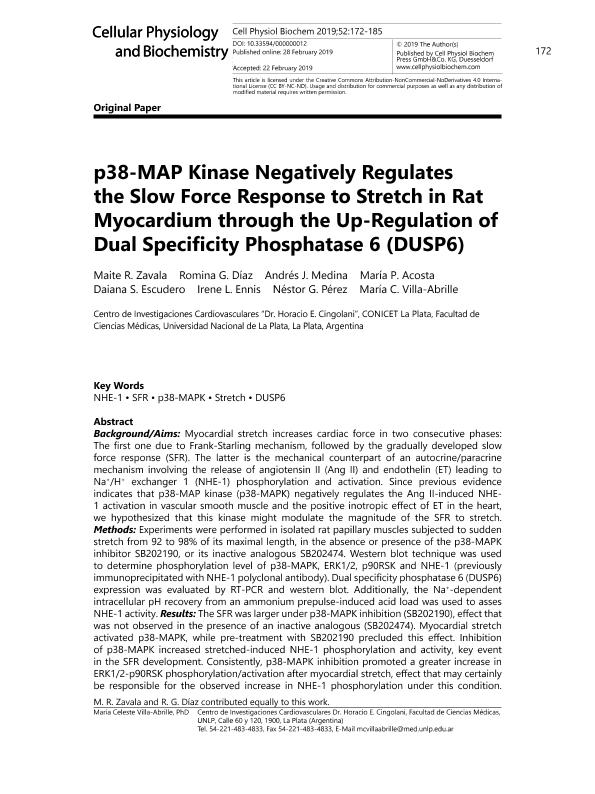Artículo
p38-Map kinase negatively regulates the slow force response to stretch in rat myocardium through the up-regulation of dual specificity phosphatase 6 (DUSP6)
Zavala, Maite Raquel ; Diaz, Romina Gisel
; Diaz, Romina Gisel ; Medina, Andrés Javier
; Medina, Andrés Javier ; Acosta, María P.; Escudero, Daiana Sabrina
; Acosta, María P.; Escudero, Daiana Sabrina ; Ennis, Irene Lucia
; Ennis, Irene Lucia ; Perez, Nestor Gustavo
; Perez, Nestor Gustavo ; Villa-Abrille, María Celeste
; Villa-Abrille, María Celeste
 ; Diaz, Romina Gisel
; Diaz, Romina Gisel ; Medina, Andrés Javier
; Medina, Andrés Javier ; Acosta, María P.; Escudero, Daiana Sabrina
; Acosta, María P.; Escudero, Daiana Sabrina ; Ennis, Irene Lucia
; Ennis, Irene Lucia ; Perez, Nestor Gustavo
; Perez, Nestor Gustavo ; Villa-Abrille, María Celeste
; Villa-Abrille, María Celeste
Fecha de publicación:
28/02/2019
Editorial:
Cell Physiol Biochem Press
Revista:
Cellular Physiology and Biochemistry
ISSN:
1015-8987
e-ISSN:
1421-9778
Idioma:
Inglés
Tipo de recurso:
Artículo publicado
Clasificación temática:
Resumen
Background/Aims: Myocardial stretch increases cardiac force in two consecutive phases: The first one due to Frank-Starling mechanism, followed by the gradually developed slow force response (SFR). The latter is the mechanical counterpart of an autocrine/paracrine mechanism involving the release of angiotensin II (Ang II) and endothelin (ET) leading to Na+/H+ exchanger 1 (NHE-1) phosphorylation and activation. Since previous evidence indicates that p38-MAP kinase (p38-MAPK) negatively regulates the Ang II-induced NHE-1 activation in vascular smooth muscle and the positive inotropic effect of ET in the heart, we hypothesized that this kinase might modulate the magnitude of the SFR to stretch. Methods: Experiments were performed in isolated rat papillary muscles subjected to sudden stretch from 92 to 98% of its maximal length, in the absence or presence of the p38-MAPK inhibitor SB202190, or its inactive analogous SB202474. Western blot technique was used to determine phosphorylation level of p38-MAPK, ERK1/2, p90RSK and NHE-1 (previously immunoprecipitated with NHE-1 polyclonal antibody). Dual specificity phosphatase 6 (DUSP6) expression was evaluated by RT-PCR and western blot. Additionally, the Na+-dependent intracellular pH recovery from an ammonium prepulse-induced acid load was used to asses NHE-1 activity. Results: The SFR was larger under p38-MAPK inhibition (SB202190), effect that was not observed in the presence of an inactive analogous (SB202474). Myocardial stretch activated p38-MAPK, while pre-treatment with SB202190 precluded this effect. Inhibition of p38-MAPK increased stretched-induced NHE-1 phosphorylation and activity, key event in the SFR development. Consistently, p38-MAPK inhibition promoted a greater increase in ERK1/2-p90RSK phosphorylation/activation after myocardial stretch, effect that may certainly be responsible for the observed increase in NHE-1 phosphorylation under this condition. Myocardial stretch induced up-regulation of the DUSP6, which specifically dephosphorylates ERK1/2, effect that was blunted by SB202190. Conclusion: Taken together, our data support the notion that p38-MAPK activation after myocardial stretch restricts the SFR by limiting ERK1/2-p90RSK phosphorylation, and consequently NHE-1 phosphorylation/activity, through a mechanism that involves DUSP6 up-regulation.
Palabras clave:
NHE-1
,
SFR
,
p38-MAPK
,
STRETCH
,
DUSP6
Archivos asociados
Licencia
Identificadores
Colecciones
Articulos(CIC)
Articulos de CENTRO DE INVEST.CARDIOVASCULARES (I)
Articulos de CENTRO DE INVEST.CARDIOVASCULARES (I)
Citación
Zavala, Maite Raquel; Diaz, Romina Gisel; Medina, Andrés Javier; Acosta, María P.; Escudero, Daiana Sabrina; et al.; p38-Map kinase negatively regulates the slow force response to stretch in rat myocardium through the up-regulation of dual specificity phosphatase 6 (DUSP6); Cell Physiol Biochem Press; Cellular Physiology and Biochemistry; 52; 28-2-2019; 172-185
Compartir
Altmétricas



